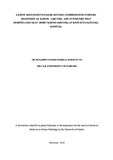Latent associated nuclear antigen-1 expression in tumours diagnosed as kaposi sarcoma and in tumours that morphologically mimic Kaposi sarcoma at Kenyatta National Hospital

View/
Date
2014-11Author
Ndibile, Benjamin E
Type
ThesisLanguage
enMetadata
Show full item recordAbstract
Background: Kaposi sarcoma(KS) mimics a variety of non-KS lesions histomorphologically
like bacillary angiomatosis and pyogenic granuloma; therefore posing a diagnostic challenge
to many histopathologists. Latent anti-nuclear antigen-1 (LANA-1) is expressed in all cells
infected by the virus, therefore immunohistochemical identification of HHV8 LANA-1 is the
gold standard in the diagnosis of KS.
Study objective: The main objective of this study was to evaluate LANA-1 expression in
KS and its histomorphological mimics at KNH.
Study design: The study design was a laboratory based descriptive retrospective study.
Study setting:The study was carried out at KNH and UoN histopathology laboratories.
Study duration: The study was done on cases reported between 1st January 2012 to 31st
December 2013 at Kenyatta National Hospital and the study was done between January
2015 and March 2015.
Study population: Cases previously reported as Kaposi sarcoma and those that
morphologically mimic KS.
Materials and methods: Fifty one cases previously diagnosed as Kaposi sarcoma and those
that morphologically mimic Kaposi sarcoma were analyzed for the expression of LANA-1
by immunohistochemistry on paraffin embedded blocks. Latent associated nuclear antigen-1
expression was correlated with age, sex, HIV status, site of the lesion and stage of
progression of the lesion.
Results: The males were 27(52.9%) while the females were 24(47.1%). M:F was 1.1:1.
Mean age was 36.9 years while the median was 34.0 years. Sixteen cases (31%) had HIV
status indicated whereas 35 cases (69%) did not. There was a positive correlation between
KS and HIV status with a p-value of <0.001. Thirty two cases (62.7%) were skin lesions, 13
cases were from oral cavity (25.5%), two were lymph nodes (3.9%) and 4(7.8%) of the cases
were from other sites. There was no correlation between KS and site of the lesion ( p-value
of 0.343). Thirty five cases (68.6%) had previously been diagnosed as KS and 16 cases as
mimics. Thirteen cases of the mimics were pyogenic granuloma, two dermatofibromas and one carvenous haemangiomas. The KS cases after review (n=33) were stratified according to
the stage of progression and the outcome was as follows; twenty seven(81.8%) of the cases
were in nodular stage, one case(3%) was in plaque stage and five cases (15.2%) were in
patch stage. There was no correlation between KS and the stage of progession ( p-value of
1.000). LANA-1 expression was 97% in cases which had previously been diagnosed as KS
while none of the mimics was positive for LANA-1 (p-value <0.001).
Conclusion: Early patch stage KS lesions pose a diagnostic challenge and therefore HHV-8
LANA-1 immunohistochemistry aids in definitive diagnosis.
Recommendations: Latent associated nuclear antigen-1 immunohistochemistry should be
recommended for early patch stage KS lesions to differentiate early KS from its mimics
Publisher
University of Nairobi
